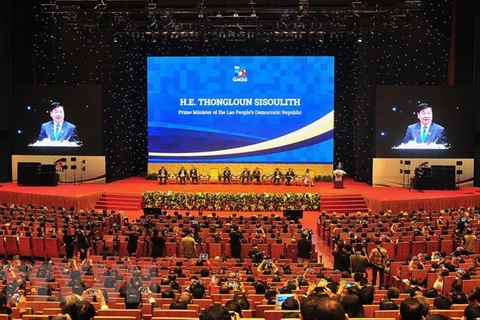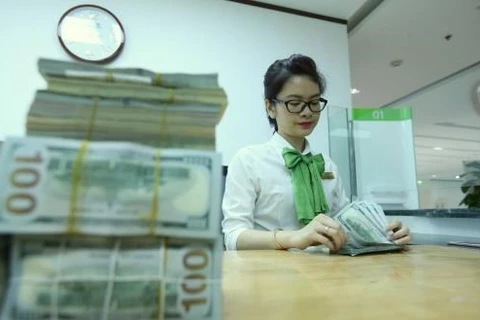Hanoi (VNA) – Credit institutions and foreign banks will be allowed to grant loans to some prioritised borrowers in excess of lending limits regulated by law beginning next month.
Under Decision No.13/2018/QD-TTg, which will take effect May 1, the Prime Minister can consider approving loans exceeding credit limits in electricity, coal, oil and gas, transport and other prioritised industries, based upon the Prime Minister’s instructions.
According to the State Bank of Vietnam, the new regulation seeks to help lenders and borrowers develop initiatives to carry out their projects, which are important to the nation’s socio-economic development.
To qualify for the loans, borrowers are required to prove they possess no non-performing loans in the three consecutive years before the loan application date, while their debt ratio must be less than three times their equity capital, according to their latest quarterly or yearly financial statements.
Their projects must also assist in the nation’s socio-economic development, improving people’s living standards in the selected industries or other priority sectors, as approved by the National Assembly or the Prime Minister.
To receive loans over the regulated credit limits, the projects must be considered feasible, as appraised by the lenders, while the financial status of the borrowers is required to be solvent.
Credit institutions are requested to make excess loans in conformity with the law, in which the loans must not exceed four times the borrowers’ equity capital.
Currently, the lending limits of credit institutions and foreign bank branches are regulated in Circular 36, which states that total loans and extensions of credit outstanding to one client is not allowed to exceed 15 percent of equity capital of the lender, while total loans and extensions of credit outstanding to a client and an associated entities do not exceed 25 percent of the equity capital of the lender.
Circular 36 also regulates that total loans and extensions of credit outstanding to one client are not allowed to exceed 25 percent of equity capital of non-bank credit institutions, while total loans and extensions of credit outstanding to a client and an associated entities do not exceed 50 percent of equity capital of non-bank credit institutions.
According to the National Financial Supervisory Commission, outstanding loans in the banking system, as of the end of March, were estimated to have risen by 3.5 percent against December last year, of which loans in Vietnamese dong increased by 3.3 percent and accounted for 91.9 percent of total outstanding loans.
The commission also reported that medium- and long-term loans during this period increased by 4.3 percent against December last year, while the rising rate for short-term loans was 2.6 percent. It pushed the medium- and long-term loan ratio up some 53.2 percent, against 52.8 percent in December last year.
In the first three months, the rising rate of mobilised capital was almost equal to that of the credit growth, posting an expansion of 3 percent.
In the first quarter of the year, interest rates averaged 0.6 percent to 1 percent per year for non-term and one-month deposits, and 4.3 percent to 5.5 percent for one- to six-month deposits. The rate for six- to 12-month deposits was set at 5.3 percent to 6.5 percent, and 6.5 percent to 7.3 percent for deposits above 12 months.
Commercial banks also listed the short-term lending rates at 6 percent to 6.5 percent per year for prioritised industries and 6.8 percent to 9 percent for normal loans.
The rate applied for medium- and long-term loans was 9.3 percent to 11 percent.-VNA
Under Decision No.13/2018/QD-TTg, which will take effect May 1, the Prime Minister can consider approving loans exceeding credit limits in electricity, coal, oil and gas, transport and other prioritised industries, based upon the Prime Minister’s instructions.
According to the State Bank of Vietnam, the new regulation seeks to help lenders and borrowers develop initiatives to carry out their projects, which are important to the nation’s socio-economic development.
To qualify for the loans, borrowers are required to prove they possess no non-performing loans in the three consecutive years before the loan application date, while their debt ratio must be less than three times their equity capital, according to their latest quarterly or yearly financial statements.
Their projects must also assist in the nation’s socio-economic development, improving people’s living standards in the selected industries or other priority sectors, as approved by the National Assembly or the Prime Minister.
To receive loans over the regulated credit limits, the projects must be considered feasible, as appraised by the lenders, while the financial status of the borrowers is required to be solvent.
Credit institutions are requested to make excess loans in conformity with the law, in which the loans must not exceed four times the borrowers’ equity capital.
Currently, the lending limits of credit institutions and foreign bank branches are regulated in Circular 36, which states that total loans and extensions of credit outstanding to one client is not allowed to exceed 15 percent of equity capital of the lender, while total loans and extensions of credit outstanding to a client and an associated entities do not exceed 25 percent of the equity capital of the lender.
Circular 36 also regulates that total loans and extensions of credit outstanding to one client are not allowed to exceed 25 percent of equity capital of non-bank credit institutions, while total loans and extensions of credit outstanding to a client and an associated entities do not exceed 50 percent of equity capital of non-bank credit institutions.
According to the National Financial Supervisory Commission, outstanding loans in the banking system, as of the end of March, were estimated to have risen by 3.5 percent against December last year, of which loans in Vietnamese dong increased by 3.3 percent and accounted for 91.9 percent of total outstanding loans.
The commission also reported that medium- and long-term loans during this period increased by 4.3 percent against December last year, while the rising rate for short-term loans was 2.6 percent. It pushed the medium- and long-term loan ratio up some 53.2 percent, against 52.8 percent in December last year.
In the first three months, the rising rate of mobilised capital was almost equal to that of the credit growth, posting an expansion of 3 percent.
In the first quarter of the year, interest rates averaged 0.6 percent to 1 percent per year for non-term and one-month deposits, and 4.3 percent to 5.5 percent for one- to six-month deposits. The rate for six- to 12-month deposits was set at 5.3 percent to 6.5 percent, and 6.5 percent to 7.3 percent for deposits above 12 months.
Commercial banks also listed the short-term lending rates at 6 percent to 6.5 percent per year for prioritised industries and 6.8 percent to 9 percent for normal loans.
The rate applied for medium- and long-term loans was 9.3 percent to 11 percent.-VNA
VNA























